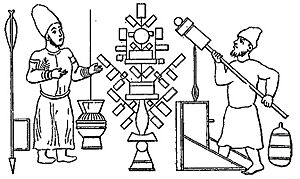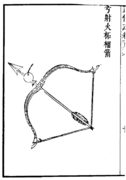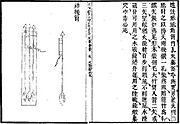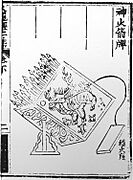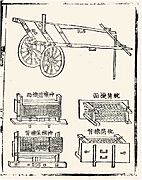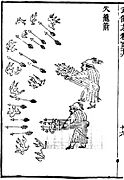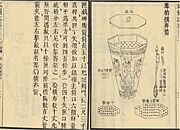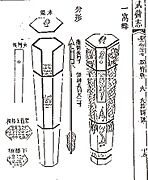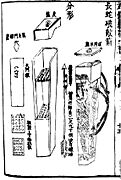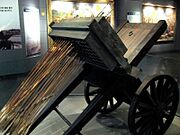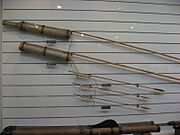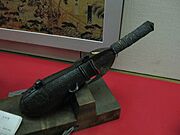Fire arrow facts for kids

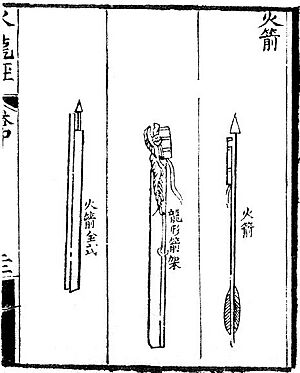
Fire arrows were some of the first weapons to use gunpowder. People started using them way back in the 800s! Don't mix them up with older flaming arrows that just had fire on them. True fire arrows used gunpowder. Their name comes from the Chinese word huǒjiàn (火箭), which means 'fire arrow'.
In China, a fire arrow was basically an arrow with a small bag of gunpowder tied to its shaft. This made it explode or burn when it hit something. These arrows were like the ancestors of fire lances, which were the very first firearms. Later, people used gunpowder to make these arrows fly like rockets. Because of this, the term 'fire arrow' became another word for 'rocket' in the Chinese language.
Contents
How Fire Arrows Were Designed
Even though fire arrows are often linked to rockets, they first started as something simpler. The original fire arrow was just a pouch of gunpowder tied to an arrow. You would shoot this type of fire arrow with a bow or crossbow. It was meant to set things on fire.
The Wujing Zongyao, an old military book, explains how to make a fire arrow:
Behind the arrow head wrap up some gunpowder with two or three layers of soft paper, and bind it to the arrow shaft in a lump shaped like a pomegranate. Cover it with a piece of hemp cloth tightly tied, and sealed fast with molten pine resin. Light the fuse and then shoot it off from a bow.
Gunpowder weapons that caused fires were better than older fire-starting tools. This is because gunpowder has its own oxygen supply. This made the flames harder to put out, similar to Greek fire. But unlike Greek fire, gunpowder is a solid. This made it much easier to store and load.
The rocket-powered fire arrow came later. By the mid-1300s, rocket arrow launchers appeared in the Ming dynasty in China. Later, mobile rocket launchers were used in China and then spread to Korea. These gunpowder-propelled fire arrows could fly very far, sometimes up to 1,000 ft (300 m) (about 300 meters).
History of Fire Arrows
The first time fire arrows were reported was in 904. The Southern Wu used them during a battle at Yuzhang.
In 969, two people named Yue Yifang and Feng Jisheng invented gunpowder-powered rocket arrows.
In 975, the state of Wuyue sent soldiers who were good at using fire arrows to the Song dynasty. In the same year, the Song army used fire arrows to destroy the fleet of Southern Tang.
The Wujing Zongyao book, published in 1044, mentions fire arrows. It says that in 994, a Liao army of 100,000 men attacked the city of Zitong. They were pushed back by war machines and fire arrows.
In 1083, records from the Song dynasty show that the court made 350,000 fire arrows. They sent these arrows to two military bases.
On March 1, 1126, the Song general Li Gang used a fire arrow machine. It was called the Thunderbolt thrower during the Jingkang Incident.
By 1127, the Jin army also started using fire arrows. They got them from Song artisans they had captured.
In 1159, the Song navy used fire arrows to sink a Jin fleet.
In 1161, General Yu Yunwen used fire arrows at the Battle of Caishi. This battle was near modern-day Ma'anshan, during a Jin attack by sea.
By 1206, people started talking about "gunpowder arrows" (huoyaojian). This was different from just "fire arrows" (huojian).
In 1245, a military practice took place on the Qiantang River. They likely used rockets during this exercise.
The Mongols also used fire arrows during their battles in Japan. Because of the Mongolian military campaigns, fire arrows later spread to the Middle East. They were mentioned by Al Hasan Al Ramma in the late 1200s.
In 1374, the kingdom of Joseon (Korea) also began making gunpowder. By 1377, they were producing cannons and fire arrows. They used these weapons against wokou pirates. Korean fire arrows were also used against the Japanese during the invasion of Korea in 1592.
In 1380, the Ming army ordered "wasp nest" rocket arrow launchers. In 1400, records show that Li Jinglong used rocket arrow launchers.
In 1451, a type of mobile rocket arrow launcher was invented in Joseon. It was known as the "Munjong Hwacha".
The Japanese version of the fire arrow was called the bo hiya. Japanese pirates (wokou) in the 1500s reportedly used the bo hiya. It looked like a large arrow. A burning part made from waterproof rope was wrapped around the shaft. When lit, the bo hiya was launched from a mortar-like weapon called a hiya taihou. It could also be fired from a wide-bore Tanegashima matchlock arquebus. During one sea battle, it was said that the bo hiya were "falling like rain."
When Were Rockets Invented?
The exact date when gunpowder-powered fire arrows, or rockets, first appeared is debated. The History of Song book says two different people invented them at different times. Feng Jisheng in 969 and Tang Fu in 1000.
However, Joseph Needham argues that rockets could not have existed before the 1100s. This is because the gunpowder recipes in the Wujing Zongyao were not strong enough for rockets. Stephen G. Haw also believes there is little proof that rockets existed before 1200. It's more likely they were not made or used in wars until the late 1200s.
Gallery
-
Depiction of a stationary fire arrow (rocket arrow) launcher from the Huolongjing.
See also
- Gunpowder
- Cannon
- Huo Che
- Hwacha
- Thai Isan Rocket Festival
- Jiao Yu
- Technology of the Song Dynasty
- Tracer ammo
- Science and technology in China
- Arrow poisons


